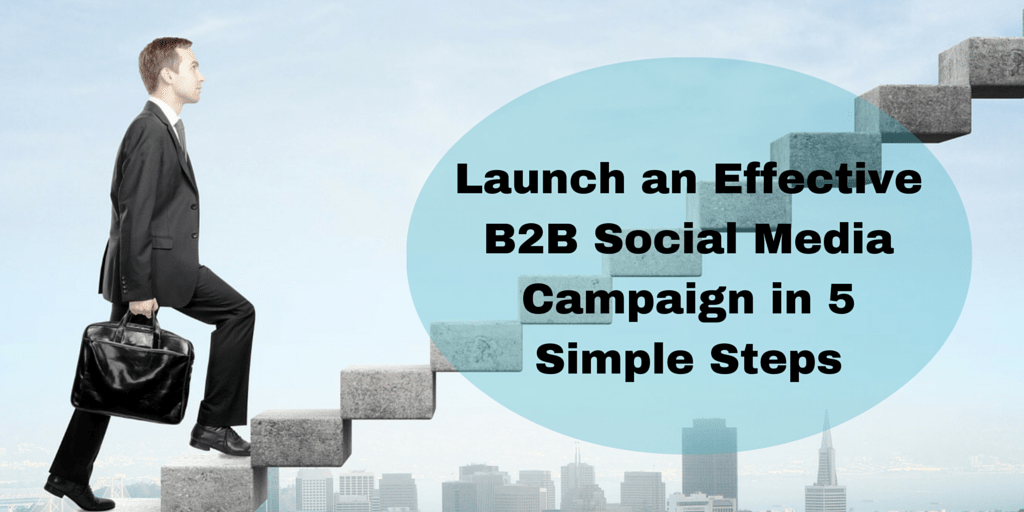A new report shows that an increasing number of B2B companies are turning to social media marketing as a primary platform for initiating and building relationships with key partners. And as expected, LinkedIn is leading the way, with more than 90 percent of B2Bs saying that they market on the platform. At number two is Twitter with 85 percent. Facebook, Google+, and Instagram are other popular social networks for B2B marketing.

The main challenge, however, is establishing a presence on social media and making it count. While being on social media will allow other businesses to find you more easily, what you do or fail to do on these social platforms will ultimately determine you success on the networks.
In the following section, we discuss the 5 most important steps when launching a B2B social media campaign.
- Have a strategy
Never forget this important step. Every marketing campaign starts with a strategy. Where there is no strategy, there will be no organization and that’s a sure recipe for chaos and ultimately failure.
Start by setting your goals (SMART goals, of course). What do you want to achieve with the social campaign? Common goals include; driving social traffic, promoting content, nurturing leads, driving paid traffic, and connecting with influencers.
The next step is to find your audience. As already mentioned, most B2B companies are on LinkedIn and Twitter. But don’t be limited by that. Instead, go out there, visit each social network, conduct surveys, and find out for yourself were these businesses really are.
Lastly, as part of creating a social media marketing strategy, you need competitor research. Try to find out which social platforms your competitors are using and where they have large followings. The platforms with the largest followings are where you need to be.
With these steps covered, go ahead and set up your business profiles on the selected platforms.
- Who manages the campaign?
When it comes to social media account management, you have two options; agency and in-house. There are pros and cons of each option.
Agency management is great because it gets the workload off your shoulders. You’ll have a dedicated company working on your campaign meaning that you can spend more time on other areas of your business. The other benefit is that these agencies are usually quite professional in what they do. They hire social media experts and work round the clock to get the job done.
The problem, however, is that agencies may not really have your interests at heart. Most of them offer blanket services that include a specified number of posts, updates, etc for each social media profile, which can be detrimental to your campaign.
In-house management will require that you invest additional resources in acquiring and training a social media staff. On the other hand, though, it grants you maximum control of the campaign.
- Select and utilize social media tools
There are hundreds of social tools out there, both free and premium, that are designed to makesocial media marketing a little easier. Even the agencies we mentioned earlier utilize these tools so you better learn about them and how best to utilize them. Here are some of the best tools;
Hootsuite: Hootsuite is by far the most effective social media management tool out there. With bulk scheduling capability, the tool is perfect for managing multiple social media accounts.
TweetDeck: This is another excellent social media management tool. It’s quite similar toHootsuite except that it is designed exclusively for Twitter management.
Buffer: Buffer’s main strength is that it makes it easy to share content on the fly. You can use the tool from within Chrome and “buffer” tweets straight from Twitter!
Other social media management tools that can prove quite useful include; Fanpage Karma, Klout, and Mention.
- Optimize your funnel
Conversion funnels are the way a marketer visualizes the customer’s journey for each marketing channel. A great funnel will allow you to formulate a logical process to guide these users, prospects, or leads from awareness to close.
In optimizing a funnel, the first step is to understand how your buyer persona behaves over a particular social media channel. How do they share content? What questions do they ask? And, who do they talk to? Do they even use social media as a way of communicating with the otherB2Bs?
There are several proven best practices for funnel optimization. For example, it’s better to find a posting frequency that works for your business and stick with it. More importantly, learn to curate your conversations. Remember that B2B marketing should be mostly about informational and meaningful conversations. Sharing your company news and relevant industry articles is a great place to start.
- Scale the campaign
This last step involves taking your campaign to the next level. This should only come after you’ve studied a channel long enough and believe that it is worth sticking to.
Scaling means optimizing and improving your campaign in a bid to increase ROI. Two tactics that will work very well here are automation and leveraging the power of influencers.
Automation means using innovative technology to make things easier. We have already mentioned several automation software programs that you can use. For example, if you’re using Twitter, then Tweetdeck will work well for you. Mention, on the other hand, will alert you every time your brand is mentioned on social media. This way, your social media team doesn’t have to waste time checking each social network to find out who is talking about you.
Leveraging the power of social influencers is something all the major brands do. Influencers, as the name suggests, are people who’ve grown insanely popular on selected social media platforms. Getting them to share your posts will bring a lot of attention and potential leads to your business.
Summary
With these five steps covered, all that is left is tracking your performance, measuring your growth, and adjusting your campaign accordingly.
Click Here for Free Download : Introduction to Business Blogging
This post originally appeared on blog.leadupmarketers.com
